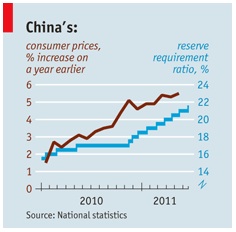In the past, Our Man has opined a lot on the difference between opinion and execution, and how it is vital to consider this difference whenever you hear someone stating an opinion (especially when it’s on a disreputable source, like CNBC) on financial markets.
To this point, just last week, Our Man shared his strongly-held skepticism about China’s economic miracle. This skepticism hasn’t done much for the portfolio, with the China thesis being a consistent negative contributor since it was added to the book in mid-10. Fortunately, the execution has been somewhat better; despite the persistent losses, the thesis has cost a mere 50bps since its inception. This is a result of the small amount of capital that’s been allocated to the trade due to Our Man’s acceptance that the timing factors haven’t fully aligned, yet…
However, there are some signs that the timing signals are finally coming around. As you will no doubt recall, a couple of the key timing signals that Our Man was waiting for were the arrival of inflation and some signs of Bank/Credit tightening (see he said it, right here). Well, as the pretty little graph (from The Economist) down below shows these elements certainly seem to showing up, with both inflation and the banks’ reserve ratio steadily climbing!
Given this, you won’t be surprised that Our Man is starting to look to increase his exposure to the China thesis and here’s a recap of the ways he’d consider doing so. As a brief reminder, Our Man can only go Short through longer-term put options (12mths+ for companies, 3-6mths+ for various ETFs) and is limited to solely investing in US-listed ETFs and companies. This eliminates a number of the more esoteric positions, which have far better risk-reward, out there in fixed income world (I’m talking Australian interest rate swaptions, CDS on Japanese industrials, etc). This inability to execute as efficiently as Our Man would like is also why the China thesis, despite Our Man’s strong opinion, will never be as large a position as it could be (given that strong opinion).
- Commodity (and Commodity-related) Companies
The argument for betting against these names is simple; China is both the major and the marginal buyer of their products. For example, China represents over 40% of the global demand for copper, or over ½ of global demand for Steel (and thus directly and indirectly Iron ore). Furthermore, much of the shenanigans to circumvent the credit tightening at the banks is through the use of commodities (originally copper, now it has allegedly progressed to other commodities following a government crackdown on using copper) as collateral, meaning the behavior of real demand is less clear than it appears. As such, should a slow-down happen in China… the likely impact will be larger on commodities and related companies than people expect.
- Australia
Not much has changed in Australia, since Our Man talked about it at length a year ago. The economy continues to benefit from its large supply of raw materials and households continue to pile on more (largely mortgage) debt. Much like the rest of the China thesis the timing factors have improved, most notably home prices have started to slide, which has resulted in an increase in the number of homes for sale. This has a certain similarity to the 2006-7 period in the US, and we’ll see if the Australian Banks’ claims that they have been better at underwriting mortgage risk than their US peers holds true. Unfortunately, the only real way Our Man can play Australia remains EWA (an ETF) and some Australian-listed commodity companies that have US ADRs.
- Brazil
The one region that has become vastly more interesting as a potential short over the last year is Brazil. Brazil has a similar underlying story to Australia; it’s a vast producer of raw materials (especially iron ore and soy products) and thus exports a great deal of this to China (though it lacks Australia’s proximity). However, despite these large exports to China the country remains a net importer overall. What’s more (and spot the trend here) there are signs of potential credit issues looming, after a strong period of credit growth (credit doubled between 2002 and 2010) and an infrastructure that’s not yet developed for such credit growth (i.e. Banks can’t see a customer’s total credit outstanding, just their credit outstanding with the bank). What’s yet more interesting, is that the timing factors are also lining up well, with the Brazilian yield curve becoming inverted (see here) – while this is no guarantor of recession, it’s typically a sign that the market expects one in the coming year or so (e.g. the US yield curve became inverted in mid-07). The final benefit of a potential Brazilian position is the ETF, which is large and liquid and largely consists of commodity-related and financial firms.

No comments:
Post a Comment